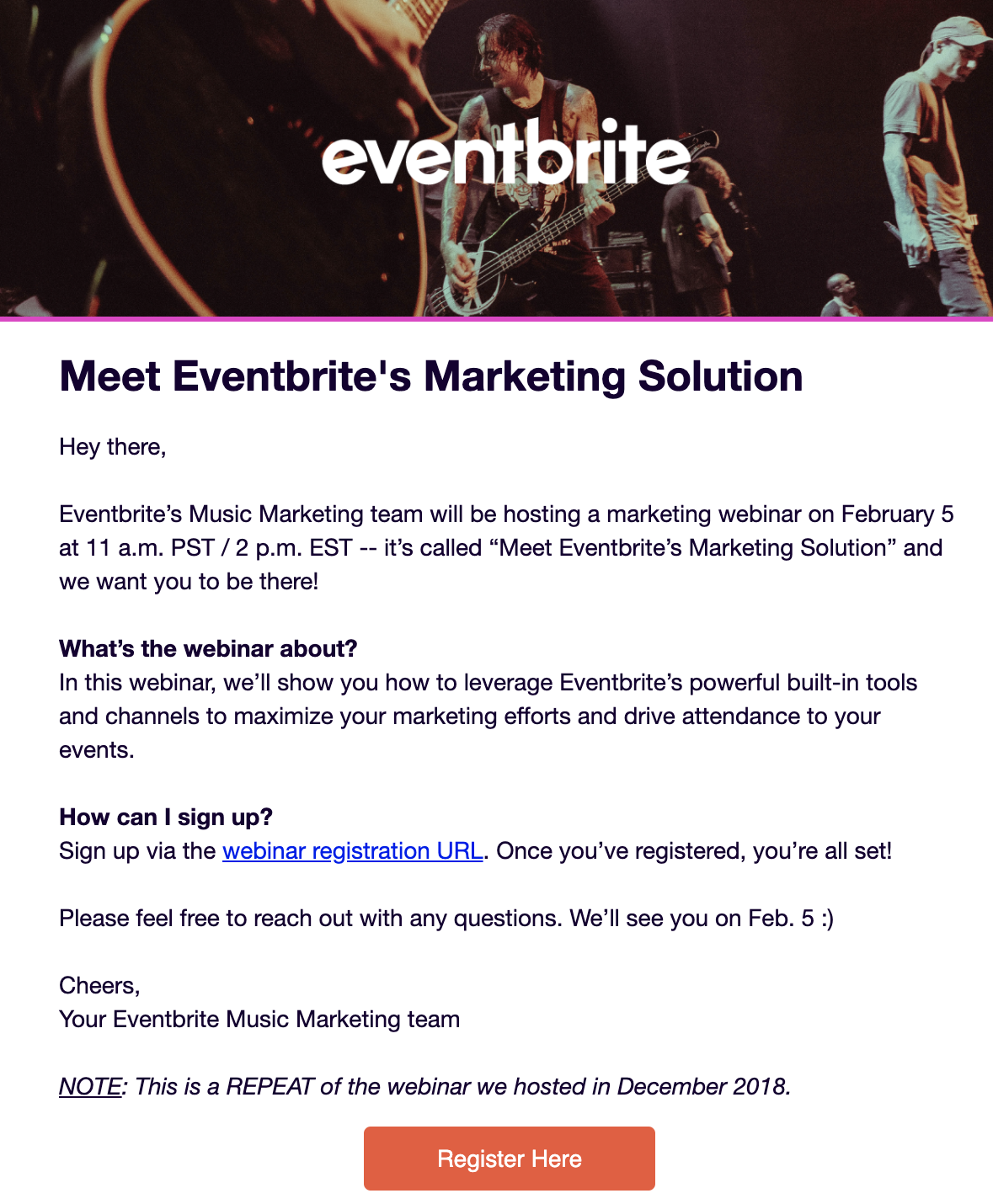As anyone in the event industry knows, no amount of planning can predict the weather, a venue or artist cancelation, or — as we’re currently dealing with — a global pandemic. When unexpected setbacks derail your event, a contingency plan will help you decide your next move. But what if you don’t have one?
The bottom line is despite your expertise and experience, adaptability is still the most beneficial skill you need as an event professional. And with a whole slew of digital formatting options, you can more seamlessly pivot in any given challenge.
New to hosting online events? Check out this collection of resources.
Some call it a livestream, others call it a webinar or virtual event. All that matters is that your attendees’ expectations are satisfied — or, better yet, exceeded. Read on to find out how.
Look on the bright side of online events
Not only are you able to salvage your event in the face of external measures, there are direct benefits to your new online format. You can:
- Open up your event to more people
- Save on costs like travel, vendors, and venues
- Leverage social tools and chats to keep the conversation going
Determine if your event is suited for an online audience
What works offline in the real world might not in the virtual. But that doesn’t mean your online workshop, class, or seminar has to be subpar. Providing a quality experience is possible in any format.
A concert or performance livestream would be perfect for the digital experience because it broadens the scope of your event beyond physical boundaries and makes online guests feel like they are part of the action. In contrast, an atrium building workshop that requires attendees to use physical materials they don’t own or possess wouldn’t work.
Events that are typically forums for discussion and thought leadership, like a town hall about closing the gender pay gap could add similar value in an online format. And if you’re worried about losing the benefits of networking, don’t. By encouraging guests to engage in the comments and chat section you provide a space for people to interact, share their thoughts, and discuss the event in real time.
Choose the right technology
You’ll need to decide on the platform you’ll broadcast your live event or online presentation from. If you’d like to display your venue’s set up and background — or feature a performer — a video streaming service like Facebook Live is most appropriate.
Sometimes you’ll need to adopt a tool that prioritizes event-goer participation. For this format we recommend Zoom, which allows you to:
- Integrate with Facebook and YouTube platforms
- Solve for interactivity with chat features and Q&A polling.
- Include virtual hand-raising and track how interested your audience is with your content
Of course, if you’re looking for a seamless registration and ticketing experience, you’ll need an advanced ticketing platform that will allow you to create a pricing strategy and offer multiple ticket types. Modern ticketing and registration platforms like Eventbrite will make promoting your online event effortless with registration and marketing integrations for Facebook and Instagram.
Don’t skimp on production equipment
Part of feeling like you’re there is having a seamless audio and visual experience. Here are a few checkpoints to make sure your audiences remains engaged:
- Test your video and audio before your event: You’ll be able to fix any issues before they impact your guest experience
- Use a good quality camera and headset: The camera on your computer will get the job done, but it’s important to remember your audience. People attend in-person events and gatherings for the rich, immersive experiences they offer. So invest in a quality camera and microphone to ensure your presence on their screens is sharp and clear.
- Make sure your connection is solid: It’s a total bummer if spotty wifi means your live music set cuts out every 3 minutes. Quality is best on a solid wired internet connection, otherwise, just make sure you have serviceable Wi-Fi.
Hone your presentation skills
You may be a skilled MC, but working with an in-person audience is quite a bit different from engaging digital guests. Consider these tactics to make sure you keep their attention:
- Look at the camera: This tactic will mimic the in-person feeling of eye contact. Gauge reactions by looking at the screen, but alternate by looking at the camera so the audience feels like you’re really talking to them.
- Use engagement tools: When it’s appropriate incorporate screen share, annotate shared content, send out polls, and solicit feedback in chat.
Manage the logistics of going from in-person to virtual (for Eventbrite Creators)
Now that you know how to host an online event that will rival your in person experience and wow your attendees, take a look at some of the logistical things you’ll need to manage when making the change:
Online-only event set up: Customize ticket types and opt-in experiences when hosting digitally to allow for a seamless experience.
Set up a paid webinar: Zoom and Eventbrite have teamed up to make this process as smooth as possible. Create your webinar in Zoom and log in to your Eventbrite account to establish this event online.
Automate most of your online event activities: Use Digital Links to set up reminders and features like material access.
Invite your audience to join you online: Just like you would for any event, you need a tactical promotional plan for your online events. Start by inviting everyone in the ways you always have for in-person events: email newsletters, social media, add your online event to Facebook, website updates.
Here’s an example:
 For live online events, though, there’s an extra step you should take: Send out a reminder about an hour before the event is due to start.
For live online events, though, there’s an extra step you should take: Send out a reminder about an hour before the event is due to start.In your communication, make it clear that this is an online event and that anyone is welcome. If you’re charging for the event, make that information explicit as well.
Change your event from in-person to virtual: If you need to change the location of your event from a physical address to a virtual one follow these steps.
- Click on your event under “Manage events” in your account.
- Go to “Basic info” on your Event Dashboard.
- Select the pencil icon next to your event location.
- Click on the dropdown “Venue” and select “Online event”. Follow the steps to create a livestream event page.
There are a couple of extra steps you’ll want to remember when you change your in-person event to a virtual event.
- Make sure to communicate the changes to your attendees.
- When you go from a physical location to online, Eventbrite won’t automatically send the link of the livestream to your attendees. You can include the link in your email to attendees or send it out at a later time.
5 action steps to encourage attendee participation
Research shows that 47% of people are more likely to ask a question at a virtual event and 37% are more likely to speak to a person in a virtual booth than a real one. There’s plenty of opportunity to boost audience participation, you just need to know how.
Whether you’re hosting an online yoga workshop, livestream folk concert, or a multi-session industry conference, your virtual gathering will benefit from strong communication throughout.
-
- Create natural pause points for people to chime in.
Attendees can only give their full attention for so long. Working moments of pause into the rhythm of your event, where viewers can comment, vote, or ask questions about the content can help you keep interest high. - Put a face to the voice.
Listeners use facial queues, posture, and stance in addition to the words being spoken to understand what’s being said. Make it easier for the human element to shine by putting a face to the voice of the host by using video. - Use interactive features.
Live polls, live chat, and live Q&A during or at the end of an online event all help break down the barriers between audience and host. If you’ve got a virtual conference, consider also making virtual booths available. - Enlist a passionate speaker/performer/talent.
There’s nothing worse than getting into a webinar and realizing that the speaker is on autopilot about their content. Make sure your speakers are excited, knowledgeable, and organized. - Ensure your technology is up to the task.
Hosting your event online is a lot cheaper than holding it in person, but you still want to make sure you’re set up for success. That means doing your research on different software and choosing the best platform to host your virtual event on.
- Create natural pause points for people to chime in.
Conclusion
Putting on a great event is no easy feat. But with these tips and your ability to adapt, you can offer in-person attendees an experience worth paying for.

